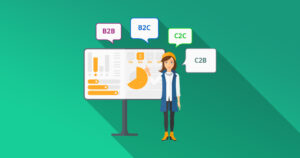E-commerce has revolutionized the way we shop and conduct business. While most people are familiar with online shopping, there are various types of e-commerce models that cater to different needs and market dynamics. In this article, we will delve into the different types of e-commerce, including Business-to-Consumer (B2C), Business-to-Business (B2B), Consumer-to-Consumer (C2C), and more.

Business-to-Consumer (B2C) E-commerce
Business-to-Consumer e-commerce, also known as B2C, is the most common type of online shopping. It involves transactions between businesses and individual consumers. B2C e-commerce platforms enable businesses to sell their products or services directly to customers through online stores. This model offers convenience, a wide range of products, and personalized shopping experiences. Popular examples of B2C e-commerce platforms include Amazon, eBay, and Shopify.
Business-to-Business (B2B) E-commerce
Business-to-Business e-commerce, or B2B, involves transactions between two or more businesses. In this model, businesses sell products or services to other businesses through dedicated online platforms or marketplaces. B2B e-commerce platforms streamline procurement processes, enable bulk orders, and facilitate negotiations between buyers and sellers. Examples of B2B e-commerce platforms include Alibaba, Thomasnet, and Magento.
Consumer-to-Consumer (C2C) E-commerce
Consumer-to-Consumer e-commerce, known as C2C, facilitates transactions between individual consumers. C2C platforms provide a digital marketplace where individuals can buy and sell products or services directly to other consumers. These platforms act as intermediaries, connecting buyers and sellers, and often offer features such as user ratings and secure payment systems. Prominent C2C platforms include eBay, Craigslist, and Facebook Marketplace.
Consumer-to-Business (C2B) E-commerce
Consumer-to-Business e-commerce, or C2B, occurs when individuals sell their products or services to businesses. This model is commonly seen in freelance marketplaces and platforms that connect businesses with independent professionals, influencers, or content creators. In C2B e-commerce, individuals offer their skills, expertise, or unique products to meet business demands. Examples of C2B platforms include Upwork, Fiverr, and Shutterstock.
Government-to-Business (G2B) and Government-to-Consumer (G2C) Ecommerce
Government-to-Business and Government-to-Consumer e-commerce models involve online transactions between governmental organizations and businesses or individual consumers, respectively. G2B e-commerce platforms provide businesses with opportunities to bid for government contracts, access public procurement processes, and interact with government agencies. G2C e-commerce platforms enable citizens to access government services, pay taxes, renew licenses, and conduct other administrative tasks online.
Conclusion
E-commerce encompasses various models that cater to different transaction types and participants. From B2C and B2B platforms that connect businesses with consumers and other businesses to C2C platforms facilitating peer-to-peer transactions, each type of e-commerce brings its own advantages and dynamics. Understanding these types of e-commerce allows businesses and individuals to navigate the digital marketplace effectively and find the right platform for their specific needs.
Add great search to your eCommerce site




